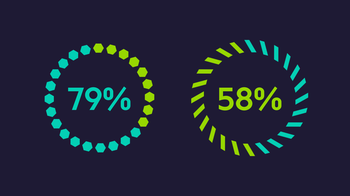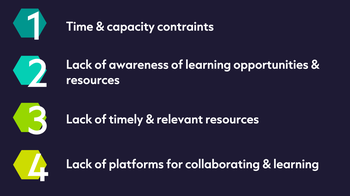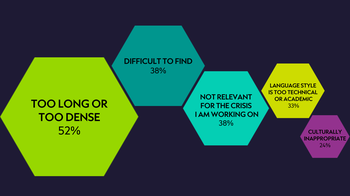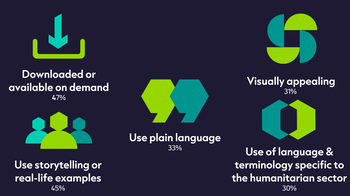ALNAP’s research into how to best communicate research and evidence to bring improvements in humanitarian policy and practice found little evidence was out there to support meaningful guidance.
So, in partnership with Devex, we surveyed more than 1000 humanitarians working in different roles and for different organisations globally to uncover trends in how learning and knowledge-sharing takes place across the humanitarian sector.
The aim of the survey was to better understand the challenges humanitarians face in accessing and applying knowledge and evidence to improve humanitarian responses. We also wanted to explore the learning methods, sources and resources they prefer.
Here are some of the findings:
MOTIVATION
We found a high percentage of survey respondents endorse the importance of learning, agreeing that humanitarian learning leads to better outcomes for people affected by crises.
- 95% of humanitarian survey respondents agree or strongly agree that finding and applying learning helps make a bigger difference for people affected by crisis

EASE OF ACCESS
Respondents largely agreed that they know where to find knowledge and evidence and don’t have difficulties accessing it.
- 79% of humanitarian respondents agree or strongly agree that they know where to find knowledge & evidence to inform their work.
- 58% have no difficulties accessing the knowledge & evidence they need to inform their work.

BARRIERS TO LEARNING
We asked each respondent to name the top three things that prevent them from learning more effectively. Shortage of time and capacity and being unaware of available learning opportunities and resources were the top issues.

LIMITATIONS OF KNOWLEDGE & EVIDENCE PRODUCTS
Long, dense documents appear to be the biggest limitation preventing humanitarians engaging with learning products.
Contrary to the survey results in Figure 2, on this question more than a third felt knowledge and evidence can, in fact, be difficult to find.
46% of respondents said time & capacity constraints are the biggest barriers to learning.

SPACES FOR LEARNING
We also asked where humanitarians mainly go to gain or exchange knowledge and evidence. Online platforms are the most common spaces to engage with learning.

Professional networking apps also hold lots of potential.
- 80% of survey respondents think social media & chat apps are generally effective platforms for gaining & exchanging knowledge & evidence
- 60% use LinkedIn for gaining and exchanging knowledge & evidence

LEARNING FORMATS
When it comes to learning formats, humanitarians say they prefer a mix of different approaches including interactive training, workshops or events, practical tools, first-hand human experience, and both short- and long-form documented evidence.

MAKING LEARNING MORE ACCESSIBLE AND ENGAGING
Being able to access knowledge and evidence in a way that suits busy humanitarians would help nearly half the respondents engage with learning products at a time convenient for them.
The element of human interest in the content they engage with is also important to them.

What part of the sector do survey respondents work in?
The majority of survey respondents (35%) work for international NGOs. Others work in the following areas: consultancy (22%), UN system (11%), donor government department (10%), host government (2%), national NGOs (6%), training organisations (4%), private sector (3%), Red Cross & Red Crescent Movement (3%) and the remaining respondents work variously in media, academia, finance and philanthropy.
5 key takeaways
- MOTIVATION – Humanitarians don’t need to be convinced of the value of learning. They are already aware of its importance. This implies the motivation to learn and improve humanitarian action is not a barrier.
- LACK OF TIME – Getting humanitarians with busy schedules and heavy workloads to engage with learning content is one of the biggest challenges for those seeking to communicate humanitarian learning in ways it can have a positive impact.
- ACCESSIBILITY OF KNOWLEDGE AND EVIDENCE – Making knowledge and evidence more accessible – in a mix of formats to suit busy schedules, such as summaries and shorter documents using simpler language, and in downloadable formats for workers on-the-go – could help.
- HUMAN CONTENT – Relatable, firsthand experience inspires humanitarians to engage with learning. Putting the ‘human’ into humanitarian knowledge and evidence could be key to increasing interest and engagement in learning products or activities.
- CREATING AWARENESS – More needs to be done to create awareness of what knowledge and evidence is available for certain humanitarian audiences, according to their specific needs. This means getting a good understanding of the platforms or channels they use at work, so relevant learning in an engaging format can be more directly targeted at them.
In 2024, ALNAP will be publishing further findings and guidance on effective ways to communicate humanitarian learning. Keep checking back.